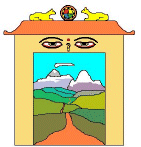
|
The Namche Conference: May 24-26,
2003 Participants and Presentations:
Ms. Irene Herremans |
|
Prof. Irene Herremans (Calgary, Canada) Associate Professor, Haskayne School of Business. Email: irene.herremans@haskayne.ucalgary.ca; and Mr. Robin E. Reid (Kamloops, BC, Canada). Email: rreid@cariboo.bc.ca Abstract: Tour Operators in the Canadian Rocky Mountains: Developing Environmental Management Systems As interest in outdoor recreational activities continues to increase, the most likely venues for these activities will be national parks and other protected natural areas. Increased visitor use of these areas suggests that environmental footprints will continue to grow unless measures are taken to decrease the impact of both visitors and service providers. Because the providers of outdoor recreational activities (in the case of this research, tour operators) have direct contact with consumers of these activities, the providers are in the best position to work with regulators to provide a solid and consistent message as to appropriate behavior for some of those engaging in outdoor activities. Due to tight budgets that do not allow for adequate regulatory systems, recreational areas are moving toward self-regulatory means such as sustainable certifications and environmental management systems (EMSs) that direct responsible behavior from within their own operations. This research project is designed to accomplish the following main objective: determine to what extent tour operators who use natural, public-owned assets as a main feature of their business operations have developed formal or informal EMSs. It further determines which elements of EMSs are used most frequently and most successfully in order to share "best practices" with other operators. With this information a plan can be developed for knowledge sharing and education of all tour operators. The research also determines which variables drive the use of elements of EMSs to ensure good environmental performance. The findings suggest that operators that expect environmentally related business outcomes, possess supply side tourism development values, and have more business experience will use more EMS elements and will find them more useful in ensuring good environmental performance. The findings can be used to design appropriate training programs, considering the barriers that might be encountered in encouraging tour operators to implement certain policies and procedures. Where barriers are low, because EMS elements are widely recognized as useful, educational processes can use "learning by assimilation" methods. However, if barriers are high, requiring a change in beliefs and attitudes before the element will be used, "learning by accommodation" methods would be more appropriate. This article proceeds as follows. The new direction for national parks is discussed. Then, background information on formal and informal EMSs prepares the reader to understand the elements of EMSs that tour operators use in Western Canada in the Rocky Mountains area. Thereafter, the reasons some operators use and find useful more elements than others are discussed. Finally, recommendations are given as to how the findings of this research can be used to design training and development programs for tour operators to improve their EMSs and thus decrease the ecological footprints in recreational areas. Keywords: Environmental Management System; Tour Operators; Self Regulation; Education Programs, Nature Tourism, Western Canada Rocky Mountains
|
Email: info@namche.net
